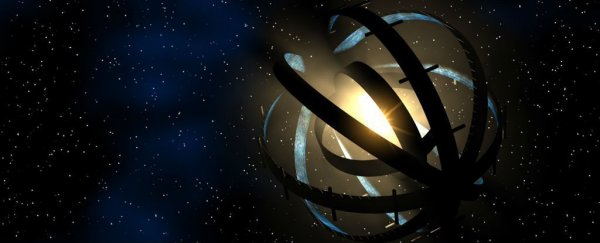We all got pretty hyped-up a few months ago when astronomers discovered evidence of a something huge and unexplainable orbiting a distant star that could possibly (but probably not) be a highly advanced 'alien megastructure'.
But new research suggests that the likelihood of the mysterious object being built by aliens just got even lower, because the most recent observations were flawed by inconsistent telescope use here on Earth.
ICYMI, here's what happened so far: back in October, scientists announced they'd spotted unusual fluctuations of light coming from a star roughly 1,480 light-years away in the constellation Cygnus, known as KIC 8462852, or Tabby's star.
Usually, regular dips in a star's light suggest that a planet is orbiting it, but in this case, the fluctuations consisted of dozens of uneven, unnatural-looking dips over a 100-day period.
That wouldn't be so strange, except a group of astronomers from Pennsylvania State University revealed that the light-pattern was consistent with the fluctuations you'd expect to see if the star was being orbited by a swarm of alien-constructed megastructures - such as hypothetical Dyson spheres, which, in theory, work to capture energy from a star.
There was also the more likely hypothesis that the light fluctuations were being caused by a swarm of comets orbiting the star. But, as you might imagine, people were most excited about the alien thing.
"Aliens should always be the very last hypothesis you consider, but this looked like something you would expect an alien civilisation to build," Jason Wright, an astronomer from Penn State University, told The Atlantic at the time.
SETI (Search of Extraterrestrial Intelligence Institute) promptly trained its telescope array on the star, and a few weeks later, announced that it had spotted nothing out of the ordinary.
But there was new alien hope in January, when Louisiana State University (LSU) researchers showed that Tabby's star had actually dimmed 20 percent over the last century, and that the best natural explantion we had - a comet swarm - couldn't actually explain what was going on.
And now research has shown that the data that this LSU study was based on was flawed, so we're back to square one.
The big problem with the data was where it came from: Digital Access to a Sky @ Harvard (DASCH), which is a collection of more than 500,000 photographic glass plates taken between 1885 and 1993. It's a great collection, but over the 108-year-long project, a whole range of telescopes and cameras were used to collect this data, which adds a huge amount of inconsistency into the research.
Noticing this, a team of astronomers from Vanderbilt University in Tennessee and Lehigh University in Pennsylvania decided to look back over the DASCH data themselves and account for these inconsistencies.
"Whenever you are doing archival research that combines information from a number of different sources, there are bound to be data precision limits that you must take into account," said one of the researchers, Keivan Stassun from Vanderbilt University.
"In this case, we looked at variations in the brightness of a number of comparable stars in the DASCH database and found that many of them experienced a similar drop in intensity in the 1960s," he said. That indicates the drops were caused by changes in the instrumentation not by changes in the stars' brightness." Damn.
But as disappointing as that news might be, it's just an example of science in action - researchers collect data, analyse it, draw conclusions, and then other scientists check their work. Finding mistakes in the data is a good thing, because it means we're hopefully getting close to figuring out what's real and what's not.
But the mystery of what the eff is happening around Tabby's star is still ongoing - the LSU data might have been flawed, but the original Kepler data wasn't.
"What does this mean for the mystery? Are there no aliens after all? Probably not! Still, the dips found by Kepler are real," said amateur astronomer Michael Hippke, who was involved in the study. "Something seems to be transiting in front of this star and we still have no idea what it is!"
The good news is that all the hype around the potential 'alien megastructure' means that a whole lot of astronomers around the world now have their telescopes trained closely on Tabby's star, and will be ready and waiting next time something odd happens.
The research has been accepted for publication in the Astrophysical Journal and is already published on pre-print site arXiv.
In the meantime, let's all get excited about the major Kepler announcement NASA is making tomorrow instead. More aliens?
